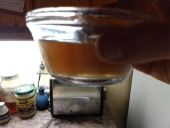Chris: So looking back along my net history, I combined these two recipes--
https://www.allrecipes.com/recipe/268199/quince-apple-sauce/
and
https://www.thepeppermillinc.com/recipes/3800/?srsltid=AfmBOopJEFwDxMxAnSBrq2OCGtrdl832s4V_kvPKY4m_T1oX24MxGVDB to get:
Quince-Applesauce:
Hand blender or other means to puree strongly recommended
Prep at least 1 quart jar and 1 pint jar with lids(I got well over a quart out of this while the recipe estimated 2 pints)
2 cups water
1 pound quinces — diced. (If not using a blender, core--and peel if that is your preference)
½ lemon, quartered and sliced (the peel is great as long as it's organic)
1 pound apples — chopped (Again, peel and core if you must-- I don't)
~½ cup honey, depending on the sweetness of your apples
1/2 tsp ground allspice or cinnamon (pretty sure I went with allspice or half/half)
pinch of ground cloves
Prep the quinces and lemon. Combine water, diced quince, and lemon in a pot over medium heat (stainless steel or intact enamel--bringing quince into contact with a carbon steel knife makes very interesting smells). Bring to a boil, reduce heat, and simmer until softened, 8 to 10 minutes. Prep apples. Add chopped apples and simmer until all fruit is very soft, 10 to 15 minutes. Add spices. Simmer for 5 minutes to blend flavors. Add honey to taste. Puree in the pot with a hand blender, or allow to cool a bit before using a blender appliance.
There's a straining step in the All Recipes process that I skipped--I don't know if
my recipe is therefore disqualified for canning because I didn't try--just heated the jars, packed them hot and let the lids pop before sticking them in the fridge.
The result is very low-waste, high-fiber, tart-sweet and
luscious. Eat hot or cold but
warm will give you the best of both worlds.






